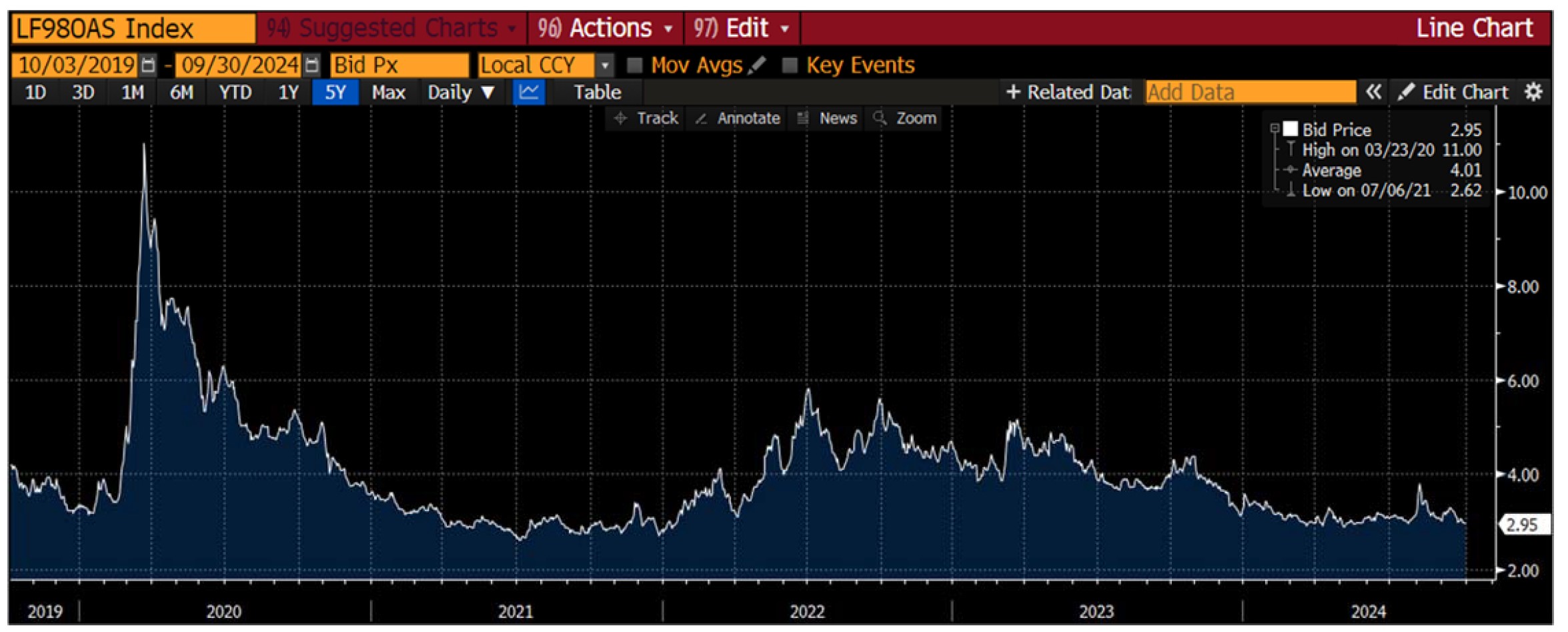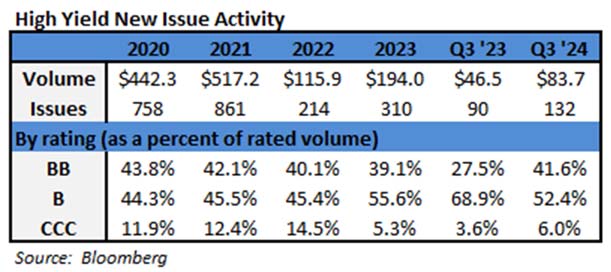2024 Q3 High Yield Quarterly
In the third quarter of 2024, the Bloomberg US Corporate High Yield Index (“Index”) return was 5.28% bringing the year to date (“YTD”) return to 8.00%. The S&P 500 index return was 5.89% (including dividends reinvested) bringing the YTD return to 22.08%. Over the period, while the 10-year Treasury yield decreased 62 basis points, the Index option-adjusted spread (“OAS”) tightened 14 basis points moving from 309 basis points to 295 basis points.
With regard to ratings segments of the High Yield Market, BB rated securities widened 3 basis points, B rated securities widened 6 basis points, and CCC rated securities tightened 166 basis points. The chart below from Bloomberg displays the spread moves in the Index over the past five years. For reference, the average level over that time period was 401 basis points.
The sector and industry returns in this paragraph are all Index return numbers. The Index is mapped in a manner where the “sector” is broader with the more specific “industry” beneath it. For example, Energy is a “sector” and the “industries” within the Energy sector include independent energy, integrated energy, midstream, oil field services, and refining. The Communications, REITs, and Technology sectors were the best performers during the quarter, posting returns of 10.99%, 6.12%, and 5.84%, respectively. On the other hand, Energy, Other Industrial, and Consumer Cyclical were the worst-performing sectors, posting returns of 2.76%, 3.21%, and 4.04%, respectively. At the industry level, wirelines, cable, and pharma all posted the best returns. The wirelines industry posted the highest return of 16.86%. The lowest-performing industries during the quarter were independent energy, oil field services, and automotive. The independent energy industry posted the lowest return of 2.03%.
The year continued with strong issuance during Q3 after the very strong start that took place in the first half of the year. The $83.7 billion figure is the most volume in a quarter since the fourth quarter of 2021 not counting Q1 this year. Of the issuance that did take place during Q3, Discretionary took 24% of the market share followed by Energy at 21% share and Financials at 16% share. YTD issuance stands at $258.5 billion.
The Federal Reserve did hold the Target Rate steady at the July meeting, but cut a half a point at the September meeting. There was no meeting held in August. The last cut to the Target Rate was back in March of 2020 and then held steady for two years before the Fed started a hiking campaign then ended with a final hike in July of 2023. The Fed dot plot shows that Fed officials are forecasting an additional 50 basis points in cuts during 2024. Market participants are forecasting a bit more aggressive Fed and are expecting 71 basis points in cuts for the remainder of this yeari. After the cut at the September meeting Chair Powell commented, “This decision reflects our growing confidence that with an appropriate recalibration of our policy stance, strength in the labor market can be maintained in a context of moderate growth and inflation moving sustainably down to 2%.”ii The Fed’s main objective has been lowering inflation and it continues to generally trend in the desired direction. However, the cooling labor market is getting more of the Fed’s attention. Even though policymakers indicated that risks to employment and inflation are “roughly balanced,” the Fed’s updated economic projections show continued deterioration expected in the labor market. Chair Powell said a continuing slump in jobs would be “unwelcome.”
Intermediate Treasuries decreased 62 basis points over the quarter, as the 10-year Treasury yield was at 4.40% on June 30th, and 3.78% at the end of the third quarter. The 5-year Treasury decreased 82 basis points over the quarter, moving from 4.38% on June 30th, to 3.56% at the end of the third quarter. Intermediate term yields more often reflect GDP and expectations for future economic growth and inflation rather than actions taken by the FOMC to adjust the target rate. The revised second-quarter GDP print was 3.0% (quarter over quarter annualized rate). Looking forward, the current consensus view of economists suggests a GDP for 2025 around 1.8% with inflation expectations around 2.2%iii.
Being a more conservative asset manager, Cincinnati Asset Management does not buy CCC and lower-rated securities. Additionally, our interest rate agnostic philosophy keeps us generally positioned in the five to ten-year maturity timeframe. During Q3, our higher quality positioning was a drag on performance as lower-rated securities significantly outperformed. Further, Index performance was very strong leading to our cash position also being a drag on performance. Additional performance detractors were our credit selections within the consumer cyclical sector and our underweight in the communications sector. Benefiting our performance this quarter were our credit selections in the energy sector, aerospace/defense industry, and construction machinery industry. Another benefit was added due to our underweight in the capital goods sector.
The Bloomberg US Corporate High Yield Index ended the third quarter with a yield of 6.99%. Treasury volatility, as measured by the Merrill Lynch Option Volatility Estimate (“MOVE” Index), remains elevated from the 78 index average over the past 10 years. The current rate of 94 is well below the spike near 200 back during the March 2023 banking scare. The MOVE Index does show a general downward trend over the last two years. Data available through August shows 17 defaults during 2024 which is relative to 16 defaults in all of 2022 and 41 defaults in all of 2023. The trailing twelve month dollar-weighted default rate is 1.72%iv. The current default rate is relative to the 1.93%, 2.38%, 2.67%, 2.15% default rates from the previous four quarter end data points listed oldest to most recent. Defaults are ticking lower and the fundamentals of high yield companies are in decent shape. From a technical view, fund flows were positive in the quarter at $5.7 billionv. No doubt there are risks, but we are of the belief that for clients that have an investment horizon over a complete market cycle, high yield deserves to be considered as part of the portfolio allocation.
The high yield market continues to hum along with positive performance and attractive yields. Corporate fundamentals are broadly in good shape, defaults have moved lower, and issuance remains robust. While GDP still looks good, there are some items to note that are relevant to the consumer, namely rising delinquencies, depleted excess savings from the pandemic, and an unemployment rate that is on the rise. Recently reported consumer confidence fell the most in three years on labor market views. The Fed commenced rate cuts and stands ready to cut more as needed. Looking ahead, rising tension in the Middle East and the approaching US presidential election should certainly keep things interesting. Our exercise of discipline and credit selectivity is important as we continue to evaluate that the given compensation for the perceived level of risk remains appropriate. As always, we will continue our search for value and adjust positions as we uncover compelling situations. Finally, we are very grateful for the trust placed in our team to manage your capital.
This information is intended solely to report on investment strategies identified by Cincinnati Asset Management. Opinions and estimates offered constitute our judgment and are subject to change without notice, as are statements of financial market trends, which are based on current market conditions. This material is not intended as an offer or solicitation to buy, hold or sell any financial instrument. Fixed income securities may be sensitive to prevailing interest rates. When rates rise the value generally declines. Past performance is not a guarantee of future results. Gross of advisory fee performance does not reflect the deduction of investment advisory fees. Our advisory fees are disclosed in Form ADV Part 2A. Accounts managed through brokerage firm programs usually will include additional fees. Returns are calculated monthly in U.S. dollars and include reinvestment of dividends and interest. The index is unmanaged and does not take into account fees, expenses, and transaction costs. It is shown for comparative purposes and is based on information generally available to the public from sources believed to be reliable. No representation is made to its accuracy or completeness. Additional disclosures on the material risks and potential benefits of investing in corporate bonds are available on our website: https://www.cambonds.com/disclosure-statements/.
i Bloomberg October 1, 2024: World Interest Rate Probability
ii Bloomberg September 18, 2024: Fed Cuts Rates by Half Point
iii Bloomberg October 1, 2024: Economic Forecasts (ECFC)
iv Moody’s September 17, 2024: August 2024 Default Report and data file
v CreditSights September 25, 2024: Fund Flows




